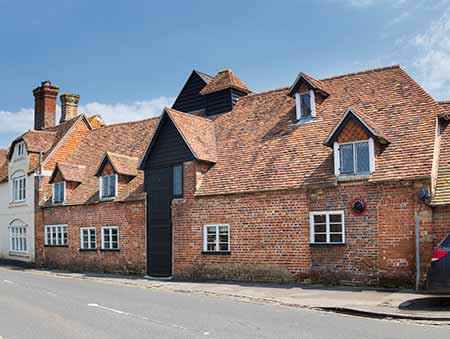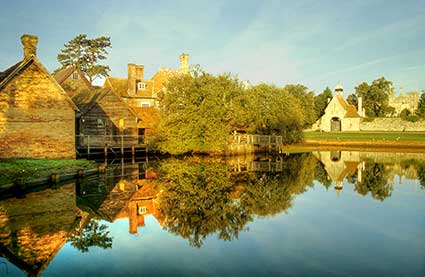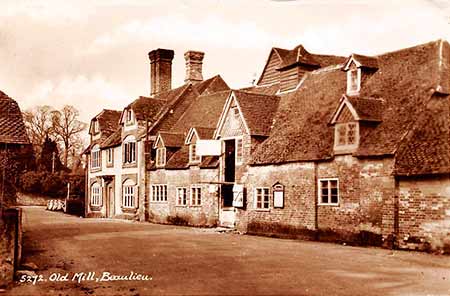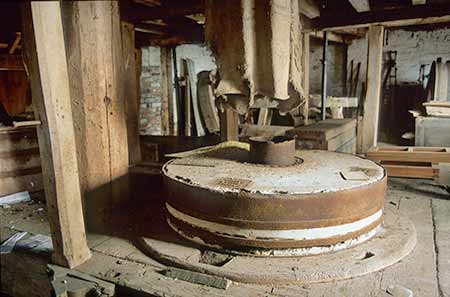Beaulieu Mill
There has been a corn mill at Beaulieu ever since Cistercian monks founded the abbey in 1204. It's thought that the first mill was located within the abbey grounds, probably close to the Outer Gatehouse, and that it might also have housed a tannery or fulling mill. But a 'molendinum forinsecum', or outside mill, was recorded as early as the second half of the 13th century, and it is thought that a tide mill has stood on the site of the present structure since the 14th or 15th century.
(1) Beaulieu Mill

Located on Beaulieu Bridge, between the village and the abbey's Outer Gatehouse, Beaulieu Mill was powered by water supplied by the incoming tide and the outflow back to sea from the nearby mill pond, which was created by abbey monks who built a dam across the Beaulieu River - the dam now carries the main road through the village.
Red brick frontage facing out towards a bend in the road contrasts with dark, wooden weather boarding at the rear. Roof tiles have long since replaced the original thatch and adjoining tall chimneys add a further dash of character. Inside, beamed ceilings in places are little more than 1.5 metres (5 feet) high. The windows are also tiny.
Rebuilt, repaired and much modified over the centuries, the present three-storey structure is a mixture of ages - standing upon medieval foundations, the mill has surviving 17th century fabric and a largely 18th century mechanical layout that was last brought up to-date at the end of the 19th century.

Details of many of the changes have been lost to the passage of time, but some were recorded or can be assumed from what remains.
In the early 18th century, for example, it is thought that the building housed a fulling mill and possibly two corn mills, each with its own water wheel; and estate records for 1743 show that a new pair of French millstones and two boulting mills were installed.
Information from the late 19th century is more complete, and shows the fitting of a water turbine in place of one of the water wheels and the acquisition of two new pairs of millstones, all supplied by Armfield & Co of Ringwood, a company well-known in Hampshire for its work on many of the county's mills.
Alterations continued into the 20th century when the turbine was replaced by an electric motor.
(2) Operation, ownership and eventual decline

It was generally reckoned that tide mill power would be available for around two 6 hour shifts each day, but at Beaulieu the mill latterly ran for only 4½ to 5 hours daily. But unlike river flows, the tides were consistently available even if they could give rise to some very unsociable working hours.
When the abbey was dissolved by Henry VIII in 1538, the mill passed into private ownership and was leased to a succession of families, including the Barneys, from 1743 until 1845, the Burdens from 1861 until 1922, and the Norrises from 1922 until 1976.
The advent of mass production processes brought about the demise of many small, local mills, such as that at Beaulieu, which could not compete with larger steam driven roller mills.

Beaulieu Mill, however, continued to grind corn until the early years of the 20th century, after which it was used to produce animal feeds until around 1942. The mill last worked in 1945 although the building remained in use as a warehouse until 1976.
The external view - above - shows the mill in the days when it was still in operation - as can be seen, the external structure remains largely unchanged to this day.
Still owned by the Beaulieu Estate and Grade II* listed, the mill is one of a small number of comparatively intact tide mills to survive in Britain. In 2014 it was subject of substantial repair and restoration works, wherever possible using local materials similar in character to the originals, following fire damage in 2006. Much of the machinery remains in-situ although it is inoperable.
Part of the floor space is now used as office accommodation.
The mill is not open to the public.
References:
A new lease of life for Beaulieu Mill: Andrew Walmsley (Hampshire - the County Magazine)
Beaulieu Estate: Beaulieu Mill, Consultants Report
An Album of Old Beaulieu: Susan Tomkins
Water and Wind mills in Hampshire and the Isle of Wight: Southampton University Industrial Archaeology Group
Hampshire Industrial Archaeology: Southampton University Industrial Archaeology Group
Quick links
More links
Other related links
Search this site

